Fahlman B.D. Materials Chemistry
Подождите немного. Документ загружается.


Table 6.6. Specific Tensile Strengths of Various Materials
187
Material Tensile
strength (MPa)
Density
(kg dm
3
)
Specific strength
a
(kN m kg
1
)
Breaking
length
b
(km)
Concrete 10 2.30 4.34 0.44
Rubber 15 0.92 16.3 1.66
Brass 580 8.55 67.8 6.91
Nylon 75 1.15 97.3 9.92
Polypropylene 80 0.90 88.9 9.06
Aluminum 600 2.70 222 22.7
Steel 2,000 7.86 254 25.9
Titanium 1,300 4.51 288 29.4
Silicon carbide 3,440 3.16 1,088 110
Glass fiber 3,400 2.60 1,307 133
Graphite 4,300 1.75 2,457 250
Kevlar
c
3,620 1.44 5,246 534
CNTs 62,000 1.34 46,268 4,716
a
The strength of a material divided by its density.
b
The length beyond which a strip of the material, of uniform width, would break under its own weight if
suspended from both ends.
c
A synthetic fiber used in bullet-proof vests, comprised of poly(paraphenylene terephthalamide).
Figure 6.68. Illustration of the deformation modes of SWNTs, resulting in a high elasticity. This behavior
is likely an artifact of in-plane flexibility of a graphene sheet, and facile rehybridization of carbon atoms
from sp
2
to sp
3
geometries. Reproduced with permission from Ajayan, P. M. Chem. Rev. 1999, 99, 1787.
Copyright 1999 American Chemical Society.
538 6 Nanomaterials
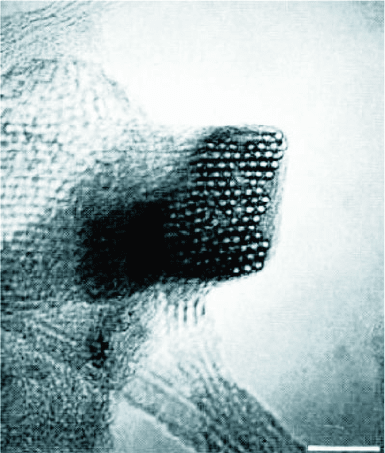
traditional composite materials used for applications that require both high-strength
and lightweight materials. There are currently plenty of examples of carbon fiber
composites – aircraft and spacecraft parts, racing car bodies, golf club shafts, bicycle
frames, fishing rods, automobile springs, sailboat masts, and many others – all
incorporating bulk carbon fibers, ca. 5–10 mm in diameter. Though this technology
has been around sinc e the 1950s, the much larger aspect ratios of CNTs translates to
an even greater impact on the future of materials reinforcement.
In order to broaden the scope of CNTs for textile applications, it is most desirable
to convert the as-formed powders into useful fibers and yarns. An intriguing recent
precedent consists of shrinking the yarn-spinning process, used by the earliest
civilizations, to the nanoregime. In this process, MWNTs from a bamboo-like forest
array were drawn into fibers, and weaved into yarns, that were both strong and
highly flexible (Figure 6.70). One possible application for these advanced nanotex-
tiles is the design of a “supersuit” for the next generation of soldier. This uniform
will feature a number of functionalities that will react appro priately to its surround-
ings (e.g., deactivation of gaseous warfa re agents, “kicking in” artificial muscles,
climate control, etc. – Figure 6.70, bottom).
Figure 6.69. High-resolution TEM image of a bundle/rope of single-wall carbon nanotubes, formed
spontaneously through the self-assembly of individual SWNTs (scale bar is 10 nm). Reproduced with
permission from Thess, A.; Lee, R.; Nikolaev, P.; Dai, H.; Petit, P.; Robert, J.; Xu, C.; Lee, Y. H.; Kim, S. G.;
Rinzler, A. G.; Colbert, D. T.; Scuseria, G. E.; Tomanek, D.; Fischer, J. E.; Smalley, R. E. Science 1996,
273, 483. Copyright 1996 AAAS.
6.3. Nanoscale Building Blocks and Applications 539

200 μm
50 μm
20 μm
50 μm
20 μm
2 μm
2 μm
Advanced display
Night vision, 360°
field of view, and
other imaging
technology would
project video data
on a visor display.
Breathing air
Respiratory protection and
climate control would be
built into the suit.
Chem and bio protection
Smart fibers would fend off
chemical and biological agents,
self-decontaminate, and become
waterproof.
Multifunctional fabric
Flexible most of the time, the battle suit
fabric would stiffen automatically
in response to ballistic danger or
on demand in a medical
emergency.
Biosensors
Vital signs would
be measured and
relayed to medics
automatically.
Artificial muscles
Connected to an
exoskeleton, these
would provide
extra strength.
Figure 6.70. SEM images of spinning MWNT arrays into fibers, and subsequent images of MWNT yarns.
Shown below is an image of a futuristic uniform to equip the next generation of warfighter. The SEM
images were reproduced with permission from Baughman, R. H. Science 2004, 306, 1358, Copyright 2004
AAAS. The image of the futuristic soldier was furnished by the Army Natick Soldier Center (http://nsc.
natick.army.mil) – refer to the Aug. 11, 2003 issue of Chemical and Engineering News for more details.
540 6 Nanomaterials
In addition to increasing strength and stiffness, the incorporation of CNTs also
imparts conductivity to the polymer matrix. The addition of CNTs also enhances the
thermal conductivity/stability, solvent resistance, and glass transition temperature of
the native polymer. Further, due to the high aspect ratio of CNTs, much lower
dopant levels are required to yield the desired properties, relative to standard
additives such as carbon black and larger graphitic fibers. There are an endless
number of potential applications for CNT composites – imagine future flat-panel
displays that are flexible, exhibiting the consistency of common fabrics; or, shirts
that are capable of monitoring the external temperature and automatically heating /
cooling. The automotive industry currently uses CNT composites for a number of
applications, such as increasing the strength of side mirr ors. In addition, CNT-doped
nylon is being used for fuel lines to reduce the buildup of static electrical charges,
and prevent fuel line rupturing during an accident.
It should be noted that reinforcement applications are not limited to organic
polymers. Th ough ceramics are already hard and chemically/thermally resistant,
these materials may also be doped with CNTs to im prove their inherent brittleness.
This has already been proven for the incorporation of 5–10% of CNTs within an
alumina matrix. The resultant material exhibits five times the fracture toughness and
seven times greater electrical conductivity relative to undoped Al
2
O
3
, with an added
property of unidirectional heat conductivity.
[187]
In order to continue the development of intriguing CNT-based composites, three
main challenges are being addressed:
(i) Ensuring a homogeneous dispersion of nanotubes throughout the polymer
matrix
(ii) Controlling the direction/orientation of the CNTs in the matrix
(iii) Separating individual SWNTs from bundles/ropes (exfoliation)
In order for efficient load delocalization and strength enhancement of a composite,
there must be a strong interaction between the dopant fibers and polymer matrix.
However, since CNTs are allotropes of carbon, they are inherently insoluble in any
solvent. Hence, there are a number of strategies that have been used to modify the
surface of CNTs to facilitate their interactions with the surrounding matrix. Not
only are these methods essential for the dispersion and self-alignment of nanotubes
throughout a polymer host (or on a surface for molecular devices), but also for the
purification of CNTs (e.g., separation of metallic and semiconducting CNTs through
selective functionalization, followed by traditional HPLC).
There are two types of surface modifications for CNTs: noncovalent interactions
(Figure 6.71) and covalent sidewall (Figure 6.72)
[188]
or defect-site
[189]
(Figure 6.73)
functionalization.
[190]
Both methods, as well as physical techniques such as sonica-
tion, are successful in separating individual SWNTs from bundles – a process known
as exfoliation. In general, it is most desirable to incorporate isolated SWNTs in a
composite rather than bundles, since the latter features poor intertube interactions
resulting in a lower overall strength – especially at low CNT concentrations.
As illustrated in Figure 6.71, noncovalent modifications consist of either
wrapping the CNT with polymers or biological macromolecules,
[191]
or placement
6.3. Nanoscale Building Blocks and Applications 541

of conjugated macromolecules on the surface through p-stacking interactions.
As such, these types of interactions have the advantage of not altering the electronic
properties of the CNT (unlike covalent modifications). However, since covalent
functionalization places specific chemical groups onto the CNT surface, this route
offers a greater potential for the selective tunability of CNT properties as well as
molecular control over the organization of CNTs for device fabrication.
The driving force behind the endcap and sidewall functionalization of SWNTs is
the strain brought about from the high degree of surface curvature. The deviation of
the carbon geometry from planarity is referred to as the pyramidalization angle, y
p
,
which is defined as 0
for the sp
2
carbon atoms in C
2
H
4
, and 19.5
(i.e., 109.5
–90
)
for the sp
3
carbon in CH
4
(Figure 6.74). Since the y
p
of the carbon atoms in C
60
is
11.6
, the desired geometry is closer to tetrahedral rather than trigonal planar. As a
result, fullerenes readily undergo addition reactions to relieve this high degree of
surface strain. Since the endcap of a SWNT may be considered as a half-fullerene
Figure 6.71. Examples of noncovalent interactions with a macromolecule solubilizing agent and CNTs.
Shown is (a) the solubilization of SWNTs with PolyT30 single-strand DNA, followed by the displacement
of the biomolecule through preferred p–p stacking between the conjugated dye methylene blue and the
SWNT surface – causing the controlled precipitation of SWNTs from solution. Also shown, (b), is another
method for solubilization/precipitation of SWNTs through use of complimentary single-strand DNA.
Reproduced with permission from Chen, R. J.; Zhang, Y. J. Phys. Chem. B 2006, 110, 54. Copyright 2006
American Chemical Society.
542 6 Nanomaterials
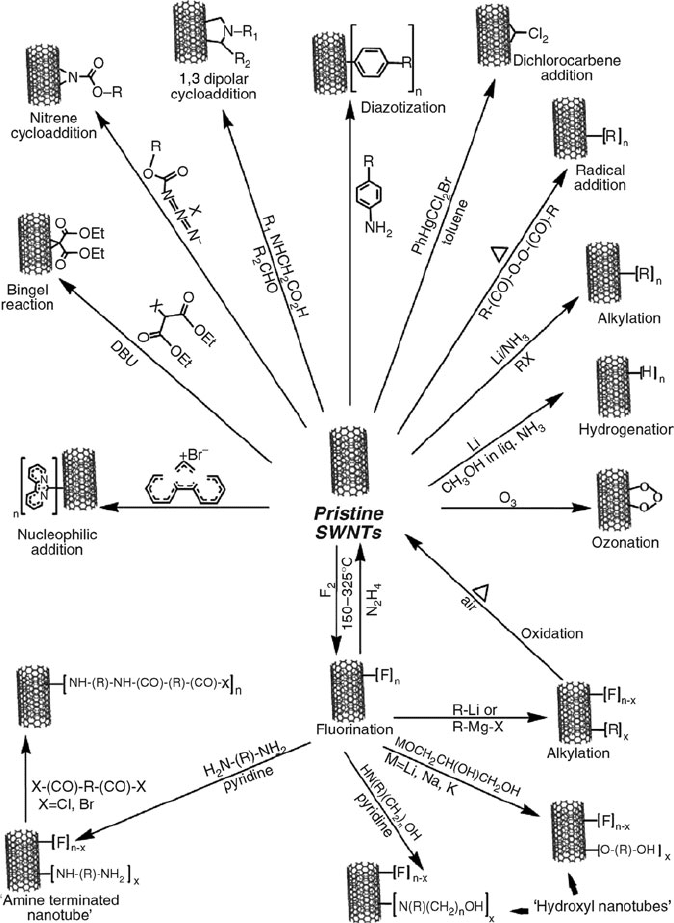
Figure 6.72. Schematic of the various methods to perform sidewall functionalization of SWNTs.
Reproduced with permission from Banerjee, S.; Hemraj-Benny, T.; Wong, S. S. Adv. Mater. 2005,
17, 17. Copyright 2005 Wiley-VCH.
6.3. Nanoscale Building Blocks and Applications 543
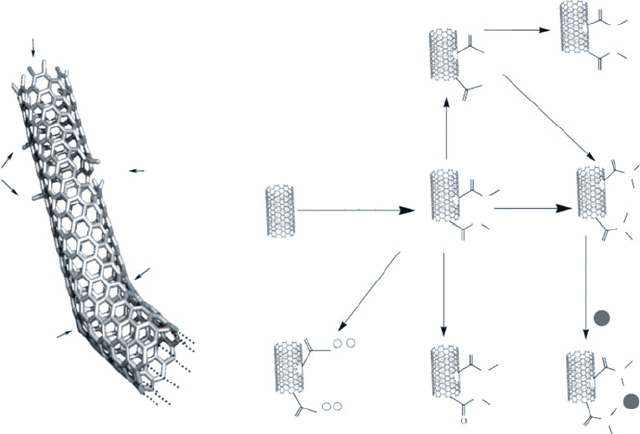
structure, with a y
p
9.7
regardless of the nanotube diameter,
[192]
these points are
highly reactive toward electrophilic addition.
In contrast, the sidewall pyramidalization angle is much less than the endcap, on
the order of 3–6
, depend ing on the diameter/chirality of the SWNT. For an
armchair (5,5) SWNT, two types of C—C bonds are present along the sidewalls –
either parallel or perpendicular to the nanotube axis. Each of these bonds exhibits a
different degree of p orbital overlap with adjacent carbon atoms, as quantified by the
p orbital misalignment angle, f (Figure 6.74). Wher eas f ¼ 0
for fullerenes,
the misalignment of neighboring p orbitals in SWNTs may be significant – as
large as 21.4
for (5,5) species. In general, a SWNT of smaller diameter has a
greater sidewall reactivity than larger analogues due to relatively large p orbital
misalignment angles (much more influential than y
p
). It should also be noted that the
overall curvature of CNTs is less than fullerenes, which make SWNTs significantly
less reactive than fullerenes.
D
R
C
A
A
R
R
R
B
R
HOOC
HOOC
COOH
COOH
COOH
COOH
Pristine
SWNTs
Oxidized
SWNTs
1) HNO
3
/H
2
SO
4
or
2) H
2
O
2
/H
2
SO
4
or
3) KMnO
4
/H
2
SO
4
or
4) K
2
Cr
2
O
7
/H
2
SO
4
or
5) O
2
/H
2
O
O
O
O
O
NH
3
R
NH
3
R
−
+
−
+
NH
2
-R
ROH
pyridine
O
O
O
O
O
O
H
R
R
N
H
R=(CH
2
)
n
SH
Metal
Colloid
O
O
O
O
O
O
O
H
H
M
R
N
N
R
M
N
R
R
O
O
O
O
O
H
H
CI
CI
SOCI
2
EDC / DCC
H
2
N-R
H
2
N-R
M
n+
L
n
M
n+
L
n
M
n+
L
n
Figure 6.73. Illustration of possible defect sites on the surface of a SWNT, along with methods used for
covalent functionalization of SWNTs at defect sites. The types of defects shown are (A) 5- or 7-membered
rings in the framework, which results in bending, (B) sp
3
-hybridized defects (R ¼ —OH, —H),
(C) oxidative surface degradation, with holes capped by —COOH groups, and (D) open end of the
SWNT shown with – COOH capping groups (may also be terminated with —OH, ═O, —NO
2
, and —H
groups). Reproduced with permission from Hirsch, A. Angew. Chem. Int. Ed. 2002, 41, 1853
and Banerjee, S.; Hemraj-Benny, T.; Wong, S. S. Adv. Mater. 2005, 17, 17. Copyright 2002 & 2005
Wiley-VCH.
544 6 Nanomaterials
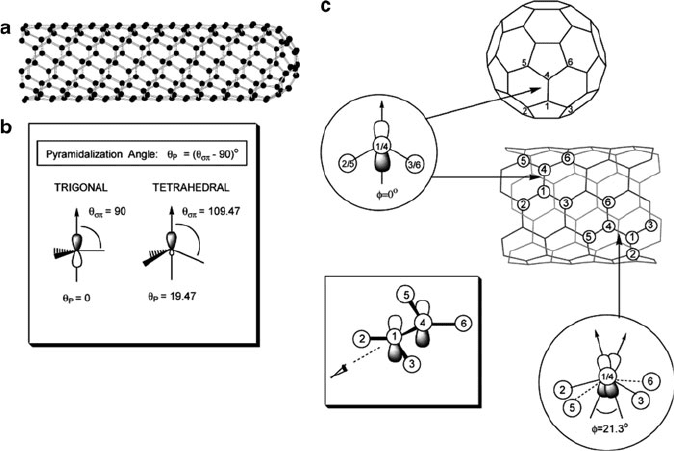
Synthesis of carbon nanotubes
Now that you are familiar with the properties and applications of CNTs, we must
now consider the techniques used for their synthesis. In addition to the experimental
details of CNT growth, this section will also provide mechanistic details on how
these interesting nanostructures form. Fortunately, recent studies have shown that
the growth mechanism of CNTs is the same for other 1-D nanostructures such as
nanowires.
There are three primary methods that are used to grow CNTs: laser evaporation of
graphitic targets, arc discharge methods, and chemical vapor deposition (CVD). You
might recognize the first two methods as also being used for to generat e fullerenes;
not surprising, sinc e CNTs are esse ntially 1-D extensions of fullerene clusters. Since
both of thes e methods involve the sublimation of graphite followed by condensation
of carbon atoms, growth occurs at an extremely high temperature – close to the m.p.
of graphite (3,000–4,000
C). To synthesize SWNTs, a catalytic amount of a nano-
sized species (e.g., metals: Co, Ni, Fe, Y, Mo, Au, Ag, Cu, Pd, Rh, Mg, Mn, Cr,
Sn, Al; semiconductors: Si, Ge; carbides: SiC, Fe
3
C; oxides: SiO
2
,Al
2
O
3
, TiO
2
,
lanthanide oxides)
[193]
must be pres ent to prevent the leading edge from closing,
which would generate spheroidal fullerenes. For MWNT growth, a catalyst is not
Figure 6.74. Schematic of (a) a metallic (5,5) SWNT, (b) the pyramidalization angles of typical sp
2
and
sp
3
carbon atoms, (c) the p orbital misalignment angles along C1–C4 in the (5,5) SWNT and its capping
fullerene, C
60
. Reproduced with permission from Niyogi, S.; Hamon, M. A.; Hu, H.; Zhao, B.; Bhowmik,
P.; Sen, R.; Itkis, M. E.; Haddon, R. C. Acc. Chem. Res. 2002, 35, 1105. Copyright 2002 American
Chemical Society.
6.3. Nanoscale Building Blocks and Applications 545
required; however, the products will contain a large number of other carbonaceous
products such as fullerenes and amorphous carbon.
[194]
Whereas arc-based methods generally contain a mixture of products, with
SWNTs/MWNTs of varying diameters/morphologies, amorphous soot, etc., a
dual-pulsed laser approach, first used in the mid-1990s, results in SWNT ropes
with >70% purity.
[195]
Though both of these methods may be used to generate small
quantities of CNTs, they are relatively expensive and not easily scalable to generate
industrial quantities. Further, the CNTs arising from vaporization methods are
typically in a tangled array, with other forms of carbon intermixed with remaining
catalytic metal (esp. affecting subsequent electronic applications).
Consequently, CVD is now the method-of-choice for the synthesis of CNTs.
As discussed in Chapter 4, this method consists of the decomposition (typically
thermal) of a hydrocarbon precursor on the surface of catalytic metal nanostructures.
Methane and acetylene have been used most extensively as precursors; other alter-
natives now include CO, C
2
H
4
, and methanol/ethanol. As with any CVD approach,
this method is easily scalable, and is used to generate kilogram quant ities of CNTs
for an ever-increasing laundry list of applications.
Most importantly, CVD is most amenable for the facile growth of vertically-
aligned CNTs known as “forests” from surface-immobilized catalyst nanoclusters.
This strategy, pioneered by Dai and coworkers at Stanford, has been used to grow
ordered arrays of both MWNTs and SWNTs using a variety of experimental
modifications.
[196]
The vertical alignment of the CNTs takes place through strong
intratube/intertube van der Waals interactions (e.g., MWNT arrays, Figure 6.75a),
tube-patterned substrate interactions (e.g., SWNT arrays, Figure 6.75b), or induced
by electric fields (e.g., SWNT arrays, Figure 6.75c). These strategies set an impor-
tant precedent of growing nanostructures along specific growth directions from
specific sites – essential for the fabrication of future integrated circuits and other
advanced electronic devices. Vertically-aligned or suitably-patterned 1-D nanos-
tructures (not limited to CNTs only) are also of use for the design of superhydro-
phobic coatings, which are able to levitate water droplets above a surface to preclude
wetting (Figure 6.76).
[197]
Beyond useful societal applications, nanotube forests may
also be grown in the shape of popular media icons or even Presidential ‘NanOba-
mas’ (Figure 6.77) – a very cool artistic application for nanomaterials, indeed!
Carbon nanotube growth emanates from catalyst nanoparticles that have been
deposited onto a substrate surface (Figure 6.78), with resultant tube diameters
related to the size of the seed catalyst. Interestingly, whe reas a number of carbon
sources such as methane and various alcohols may be used for SWNT growth from
catalyst powders, acetylene (C
2
H
4
) is a key precursor for vertically-aligned SWNT
growth.
[198]
Often, a metallic underlayer (e.g., Al/Al
2
O
3
, Cr, Ir, W, Ta, Ti) is used as
a diffusion barrier in order to facilitate and control the growth of SWNTs on
substrates such as Si, SiO
2
, or metals (e.g., Au, Ag, W, steel alloys).
[199]
The
morphology of this underlayer plays a crucial role in the overall structure (i.e.,
random 2-D vs. 3-D vertically-aligned arrays) of the resultant SWNTs.
196
546 6 Nanomaterials
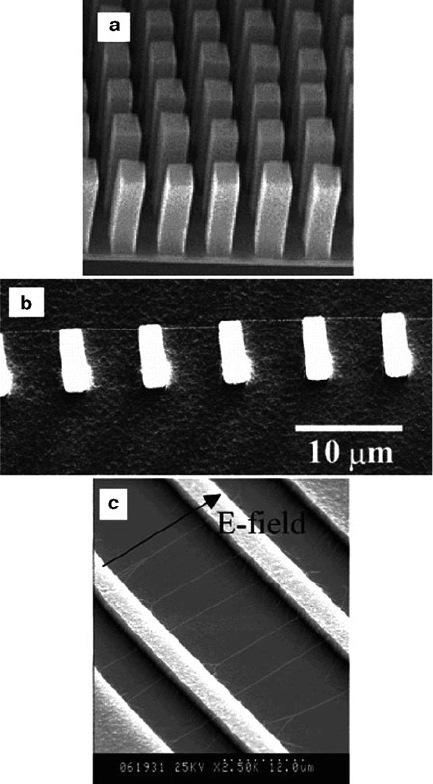
There are also reports of the one-step synthesis of aligned MWNT bundles and
Y-junction CNTs using a controlled mixture of metallocene-based precursors
(M(C
5
H
5
)
2
,M¼ Fe, Co, Ni) – precluding the use of surface-immobilized catalyst
nanoclusters.
[200]
Since the precursor acts as both the carbon source and catalyst,
Figure 6.75. Examples of the ordered growth of carbon nanotubes. Shown are (a) MWNT arrays grown
from squared regions of iron nanoclusters; (b) side-view SEM image of a “SWNT power line on Si posts”;
(c) aligned SWNT growth through electric-field induction. Reproduced with permission from Dai, H. Acc.
Chem. Res. 2002, 35, 1035. Copyright 2002 American Chemical Society.
6.3. Nanoscale Building Blocks and Applications 547
